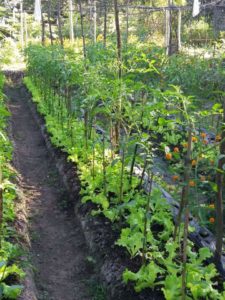This article throws light upon the top twelve types of cropping system. The cropping systems are: 1. Mixed Farming 2. Ratooning 3. Live Mulch System 4. Mixed Cropping 5. Sole Cropping/Solid Planting 6. Monoculture 7. Multi-storeyed/Multitired/Multilevel Cropping 8. Parallel Cropping 9. Companion Cropping 10. Synergetic Cropping 11. Cropping Index 12. Land Equivalent Ratio.
Cropping System: Type # 1.
Mixed Farming:
1. A system of farming on a particular farm which includes crop production, raising livestock, poultry, fisheries, bee keeping etc. to sustain and safety as many needs of the farmer as possible. The objective is subsistence while higher profitability without altering ecological balance is important in farming system.
2. Cropping pattern which involve the raising of crops, animals and or trees.
Cropping System Type # 2.
Ratooning:
One of the important methods of intensive cropping, allowing the stubbles of the original crop to strike again after harvesting and to raise another crop.
Cropping System Type # 3.
Live Mulch System:
Live mulch crop production involves planting a food crop directly into a living cover of an established cover crop without tillage or the destruction of the fallow vegetation.
Cropping System Type # 4.
Mixed Cropping:
Growing of two or more crops simultaneously and intermingled without row arrangements, where there is significant amount of intercrop competition.
Cropping System Type # 5.
Sole Cropping/Solid Planting:
1. It is opposite of intercropping.
2. “One crop variety grown alone in pure stands at normal density in a field”.
Cropping System Type # 6.
Monoculture:
The repetitive growing of the same sole crop on the same land.
Multiple Cropping:
1. “The growing of more than one crop on the same land in one year”.
2. Types of multiple cropping:
(a) Intercropping
(b) Mixed cropping
(c) Sequential/non-overlapped cropping
(d) Relay/overlapped cropping
(a) Inter Cropping:
“Growing of two or more crops simultaneously in alternate rows or otherwise in the same area, where there is significant amount of inter crop competition”.
Advantages of Inter Cropping:
1. Greater stability of yield over different seasons,
2. Better use of growth resources,
3. Better control of weeds, pests and diseases,
4. One crop provides physical support to the other crop,
5. One crop provides shelter to the other crop,
6. Erosion control through providing continuous leaf cover over the ground surface, and
7. It is the small farmers of limited means who is most likely to benefit.
Disadvantages of Intercropping:
1. Yield decrease because of adverse competition effect,
2. Allopathic effect,
3. Creates obstruction in the free use of machines for intercultural operations and
4. Large farmers with adequate resources may likely to get less benefit out of intercropping.
(b) Mixed Cropping:
Cultivation of two or more than two crops simultaneously, on the same piece of land without any definite row pattern or fixed ratio.
1. Scientific study of mixed cropping was firstly done by La-Flitze in 1929.
2. Mixed cropping is commonly practiced in Dry land areas of India.
3. Sowing of seeds is generally by broadcasting method.
4. Main objective is to lessen the risk of total crop failure, and to satisfy the farmers in food and fodder.
5. Mixed cropping needs irrigation throughout the year.

(c) Sequential/Non-overlapped Cropping:
Growing of two or more crops in quick succession on the same piece of land in a farming year. The swing of the succeeding crop and harvesting of the preceding crop may be done simultaneously or in a quick succession e.g. Just after the harvest of Maize Potato is sown and just after digging of potato. Chili is sown.
(d) Relay/Overlapped Cropping:
Relay planting is interring planting or inter sowing of seeds/seedlings of the succeeding crop before harvesting the preceding/maturing crop.
1. Generally 2nd crop is planted after the first crop has reach its reproductive stage of growth e.g. Potato is planted before the harvest of Maize and Radish is sown before harvesting of Potato.
2. Paira (Bihar & WB) and Utera (MP) cropping are also referred as an example of relay cropping. Paira/Utera cropping means sowing of Lathyrus or Lentil before the harvest of rice in lowland area with an objective to use the residual moisture of rice field.
Cropping System Type # 7.
Multi-storeyed/Multitired/Multilevel Cropping:
Two or more than two crops of different heights cultivated simultaneously on the same field. It is generally practiced in Karnataka and Kerala e.g. Sugarcane + Mustard + Onion/Potato.
Cropping System Type # 8.
Parallel Cropping:
Such crops have different growth habits and zero competition to each other. e.g. Urd/Moong + Maize
Cropping System Type # 9.
Companion Cropping:
When the production of both inters crops is equal to that of its solid planting. e.g. Mustard/Potato/Onion + Sugarcane
Cropping System Type # 10.
Synergetic Cropping:
In this type of cropping, yield of both the crops are higher than their pure crops on unit area e.g. Sugarcane + Potato
Cropping System Type # 11.
Cropping Index:
The number of crops grown per annum on a given area of land multiplied by hundred.
Cropping System Type # 12.
Land Equivalent Ratio:
Ratio of the area needed under sole cropping to one of intercropping at the same management level to give an equal amount to yield. LER is the sum of the fractions of the yield of the intercrops, relative to their sole crop yields. Intercropping system accepts advantageous, when LER is more than 1.0.
